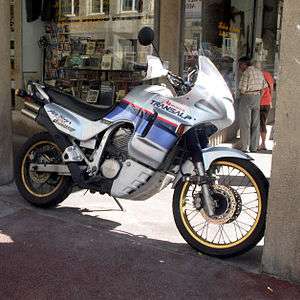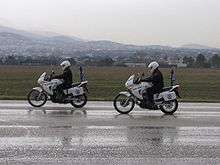Honda Transalp
The Honda Transalp is the XL400V, XL600V, XL650V, and XL700V series of dual-sport motorcycles manufactured in Japan by Honda since 1987.[1] The Transalp bikes series feature a liquid-cooled, four-stroke 52° V-twin engine.
 | |
| Manufacturer | Honda |
|---|---|
| Also called | XL600V, XL650V, XL700V |
| Production | since 1987 |
| Engine | Liquid-cooled, six-valve, 4-Stroke, 52° V-twin 583 cc (35.6 cu in) (XL600V) 647 cc (39.5 cu in) (XL650V) 680 cc (41 cu in) (XL700V) |
| Top speed | 177 km/h (110 mph) (XL600V) 180 km/h (110 mph) (XL650V) |
| Ignition type | Electric start |
| Fuel capacity | 18 L (4.0 imp gal; 4.8 US gal) |
| Related | NT650V & NT700V Deauville |
History
The first prototype was built in 1985 as an off-road motorbike with a 500 cc (31 cu in) engine. Further development introduced an increase to 600 cc (37 cu in) and more road-oriented features, notably an improved fairing.
Models

The most usual models are:
- The XL600V from 1986 - available in the United States in 1989[2]
- The XL650V from 2000[3]
- The XL700V from 2008[4]
Other versions exist, such as the 400 cc version (ND-06) aimed at the Japanese market.
The first version output 50 hp (37 kW) at 8,000 rpm, increased to 55 hp (41 kW) for the 1989 and 1990 version. Later models returned to the original 50 hp.
From 1991, the rear drum brake was replaced by a 240 mm (9.4 in) disc brake, with a single-piston brake caliper.
The appearance was altered in 1994: the original square lights were changed, and a new fairing was introduced.
In 1996, new 34 mm carburetors were introduced, and the CDI ignition system was replaced by a microprocessor-driven design.
The front brake was modified in 1997, introducing a second disc and reducing the diameter to 256 mm (10.1 in).
The weight of the Transalp increased over time, from 175 kg (386 lb) for the first models to 218 kg (481 lb) for the latest version.[5]
In 2000, the XL650V Transalp replaced the XL600V, introducing the engine from the Deauville and Honda Revere. The power output increased to 39 kW (52 hp) at 7,500 rpm, torque increased to 54 N⋅m (40 lbf⋅ft) at 5,500 rpm. A 4 mm bore diameter increase gave a 64 cc displacement increase. The shock absorbers were redesigned for road use, the exhaust system was updated, the fuel capacity increased by one litre, the control panel was redesigned, and weight diminished by 4 kg (8.8 lb).
In 2007, the XL700V Transalp was introduced, with a new 680 cc engine, which was also fitted to the NT700V Deauville, and compatible with Euro 3 emission standards. The front wheel diameter was reduced from 21 inches to 19 inches, the exhaust system was fitted with a catalytic converter, the lights were redesigned, and ABS was introduced.
The 2008 model reinforces the road orientation of the Transalp, with larger tyres, lower saddle and more road-oriented shock absorbers. The 2008 XL700V engine is a liquid-cooled, eight-valve, four-stroke, single-overhead cam, 52° V-twin.[6]

References
- "Honda XL650V Transalp (1987-2007)". Motorcycle News. Retrieved 2009-10-13.
- Landon Hall (May–June 2006). "Honda XL600V Transalp". Motorcycle Classics. Retrieved 2009-08-20.
- "Honda XL650V Transalp (1987-2007)". Motorcycle News. Retrieved 2009-10-13.
- "Honda XL650V Transalp (1987-2007)". Motorcycle News. Retrieved 2009-10-13.
- "Honda Motorcycles Models (XL700V Transalp ABS)". Honda Motor Europe Ltd. Retrieved 2009-10-13.
- "Honda Motorcycles Models (XL700V Transalp ABS)". Honda Motor Europe Ltd. Retrieved 2009-10-13.